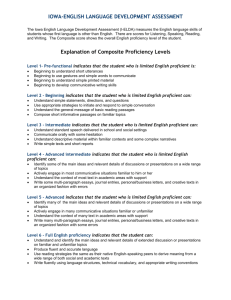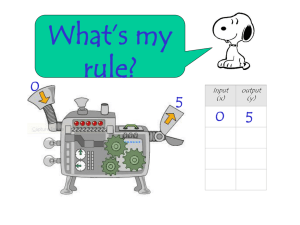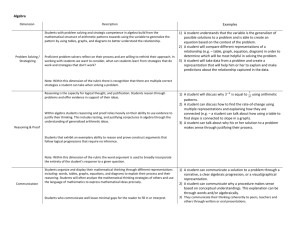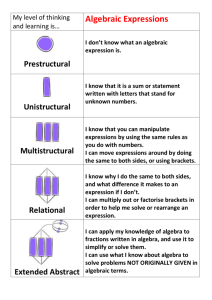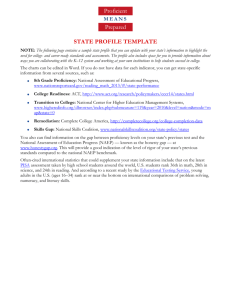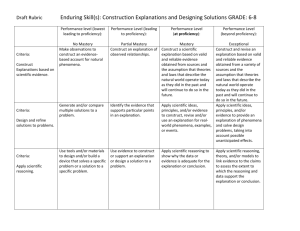Algebra Proficiency Level Definitions
advertisement
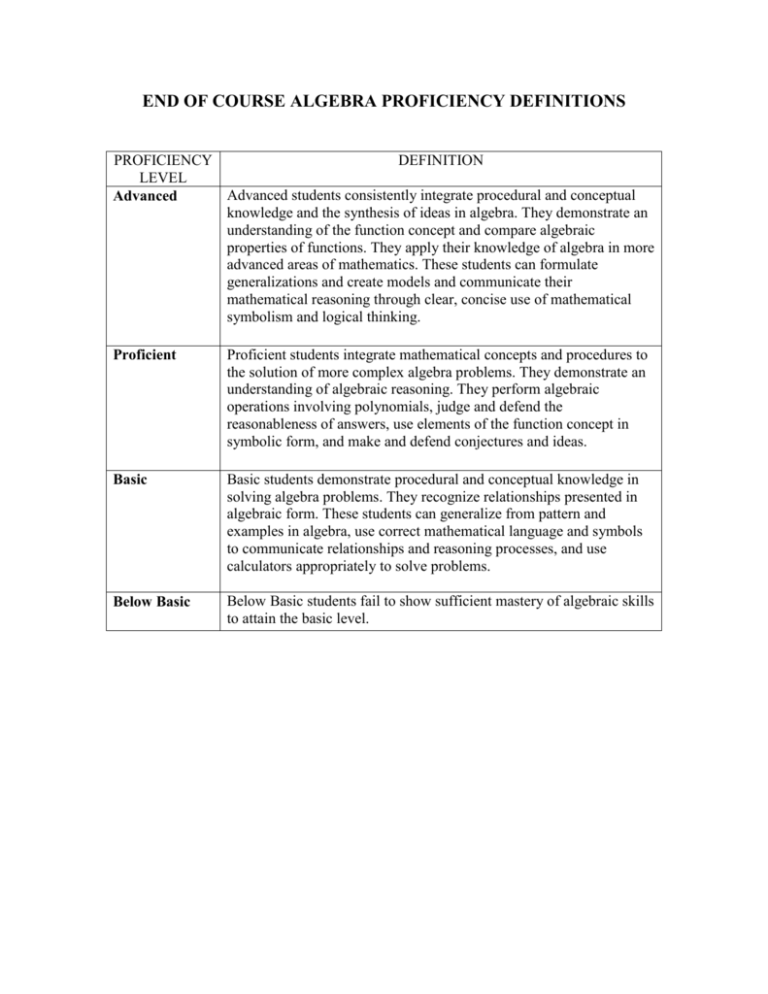
END OF COURSE ALGEBRA PROFICIENCY DEFINITIONS PROFICIENCY DEFINITION LEVEL Advanced students consistently integrate procedural and conceptual Advanced knowledge and the synthesis of ideas in algebra. They demonstrate an understanding of the function concept and compare algebraic properties of functions. They apply their knowledge of algebra in more advanced areas of mathematics. These students can formulate generalizations and create models and communicate their mathematical reasoning through clear, concise use of mathematical symbolism and logical thinking. Proficient Proficient students integrate mathematical concepts and procedures to the solution of more complex algebra problems. They demonstrate an understanding of algebraic reasoning. They perform algebraic operations involving polynomials, judge and defend the reasonableness of answers, use elements of the function concept in symbolic form, and make and defend conjectures and ideas. Basic Basic students demonstrate procedural and conceptual knowledge in solving algebra problems. They recognize relationships presented in algebraic form. These students can generalize from pattern and examples in algebra, use correct mathematical language and symbols to communicate relationships and reasoning processes, and use calculators appropriately to solve problems. Below Basic Below Basic students fail to show sufficient mastery of algebraic skills to attain the basic level. END OF COURSE GEOMETRY PROFICIENCY DEFINITIONS PROFICIENCY DEFINITION LEVEL Advanced students consistently integrate, apply, and synthesize Advanced geometric concepts. These students can correctly formulate generalizations, create models, and communicate their mathematical reasoning through clear, concise use of mathematical symbolism and logical thinking. Proficient students consistently integrate and apply geometric concepts Proficient to analyze and solve more challenging problems. They demonstrate an understanding of geometric patterns and spatial reasoning. They justify geometric relationships, make conjectures, and defend ideas using proper mathematical language and symbolism. Basic students demonstrate knowledge of geometric concepts and Basic procedures in problem solving. They demonstrate knowledge of geometric relationships and corresponding measurement skills. Basic students partially demonstrate the abilities to apply these skills. Below basic students fail to show sufficient mastery of skills in Below Basic geometry to attain the basic level. Proficiency Level Definitions End of Course Literacy Advanced In reading, students demonstrate thorough, thoughtful, and extensive understanding of the text and reflect recognition of concrete and abstract ideas. They analyze and/or evaluate purpose, meaning, form, and literary techniques, supporting their ideas with specific examples from the text and connecting them to personal experience and other readings. In writing, students respond appropriately to the task and audience, consistently employing logical cohesive organization; sophisticated use of transitional elements; illustrative and varied supporting details; and rich language to enhance meaning through control of grammar, punctuation, capitalization, and spelling. Proficient In reading, students demonstrate an overall understanding of the text that includes inferential and literal information. They identify and/or analyze purpose, meaning form, and literary techniques, supporting their ideas with examples from the text, drawing conclusions, and making connections to personal experiences. In writing, students respond appropriately to the task and audience and show logical organization. They use specific details, varied vocabulary, and language devices. They employ transitional elements effectively and have few errors in grammar, punctuation, capitalization, and spelling. Basic In reading, students demonstrate understanding and make literal interpretations of the text. They identify and/or relate some aspects of text to purpose and meaning, make simple inferences, and draw conclusions. In writing, students show evidence of organization, use supporting details, and demonstrate sufficient command of grammar, punctuation, capitalization, and spelling. Below Basic Below basic students do not show sufficient mastery of skills in reading and writing to attain the basic level. Algebra End of Course Examination Percentage of Students within Four Performance Levels Raw Score Range 0 – 28 29 – 51 52 – 72 73 – 100 Proficiency Level Below Basic Basic Proficient Advanced Percentage of Students 29.2% 49.0% 19.5% 2.3% Geometry End of Course Examination Percentage of Students within Four Performance Levels Raw Score Range 0 – 36 37 – 65 66 – 87 88 – 100 Proficiency Level Below Basic Basic Proficient Advanced Percentage of Students 33.1% 47.6% 17.5% 1.8% 11th Grade Literacy End of Course Examination Percentage of Students within Four Performance Levels Raw Score Range 0 – 135 136– 176 177 – 210 211– 224 Proficiency Level Below Basic Basic Proficient Advanced Percentage of Students 25.4% 50.9% 23.0% 0.7%
